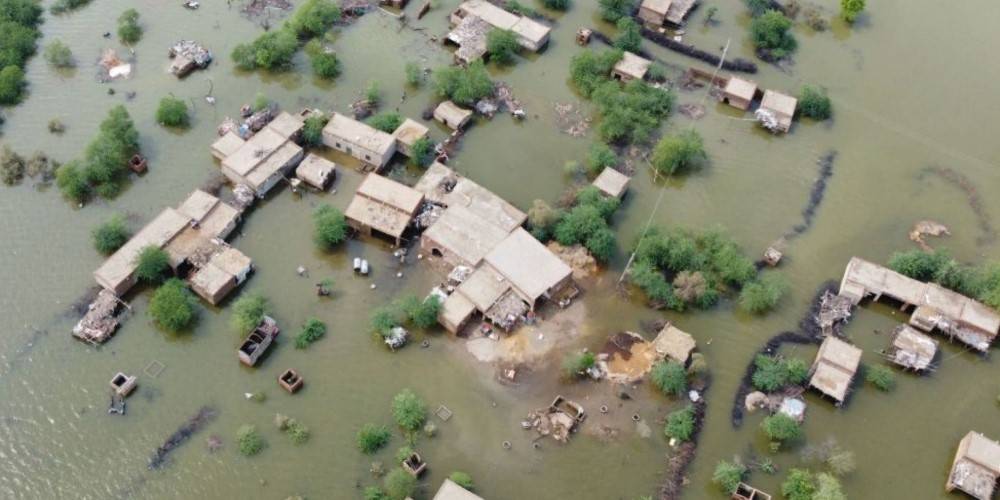PAKISTAN has been hit by unprecedented deadly floods. These are flash floods to be exact, which are caused by rapid and excessive rainfall that raises water heights quickly, overtaking rivers, streams, channels and roads.
Due to climate change, Pakistan has experienced excessive rains this monsoon season, 2.87 times higher than the national average of the last 30 years, with some areas in Sindh and Balochistan receiving more than five times the average rainfall.
Floods are the most frequently occurring natural disaster. Globally, 80 to 90 per cent of all natural disasters in the last 10 years have comprised flash floods, river floods or coastal floods. The waters sweep away everything in their path. Ill-planned infrastructure quickly collapses, causing loss of human and animal life. The international experience with floods shows that 75pc of deaths during the floods take place due to drowning.
People suffer during floods in many different ways. All of a sudden, they are washed away with their belongings and in most cases lose their livelihoods. They are uprooted from their homes and communities, they get separated from their loved ones and there is no longer any social support. As a result, they undergo extreme mental stress and, in many cases, suffer physically.
Healthcare is an integral component of any flood emergency response. However, well-meaning but inappropriate or unrelated medical aid and donations may do more harm than good. So, in order to plan an appropriate medical response, it first needs to be understood what most frequently afflicts people during floods.
Well-meaning but unrelated medical aid and donations may do more harm than good.
It is useful to think in terms of five groups of medical and healthcare problems during floods and the corresponding healthcare provision.
The first group of problems are of an acute nature and require immediate medical response. These include injuries which are caused by floodwater and the people’s struggle to save themselves from drowning, hypothermia due to being submerged in water for a prolonged period, injuries due to the collapse of buildings and infrastructure, and snakebites.
The second group of problems follows the first one in the form of the spread of waterborne diseases including but not limited to diarrhoea, especially among children, cholera, typhoid and hepatitis E. Malaria and dengue, though mosquito-borne diseases also spread during these times due to stagnant water pools which serve as breeding sites for mosquitoes. The provision of safe drinking water and food are critical not only for hydration and nutritional purposes but also to prevent the spread of waterborne diseases. Along with that, the promotion of handwashing, sanitation and other infection prevention and control measures need to be promoted.
With a growing number of environmental samples already testing positive for the poliovirus, and increasing polio cases, there is a need to carry out special polio vaccination campaigns in the flood-affected areas as and when possible.
Poliovirus can contaminate food and water in unsanitary conditions. Likewise, cholera vaccination should be considered to control likely cholera outbreaks. Measles outbreaks must also be anticipated in camps. Covid-19 vaccination should also be considered for people living in these areas.
The third set of problems comprise those which people were already suffering from but whose treatment was disrupted due to the flood emergency. Here, an understanding of the proportionate burden of diseases (BoD) in Pakistan would be helpful. More than 50pc of BoD in Pakistan is now due to non-communicable diseases. These are chronic conditions usually requiring lifelong treatment. Diabetes especially needs to be mentioned. Insulin and other antidiabetic medicines are a lifeline for patients with diabetes. Likewise, patients with blood pressure, chronic respiratory problems, etc require their medication to be continued.
The fourth group includes mental health issues. The stress of loss causes anxiety and depression. Mental health support to the flood-affected must be planned as a part of medical aid and it should not be relegated to non-essential care or as an afterthought. Trained mental health professionals should be part of the medical team.
Fifth are vulnerable groups and their special needs. Pregnant women, young children, old women and men, disabled people — all require special and prioritised attention to their condition and needs in times of emergencies.
Planning healthcare for flood victims hence requires not only medical (curative) services but also preventive, promotive and rehabilitative health services. These five groups of problems can guide us in the selection of medicines and other medical supplies and the composition of healthcare teams.
Time and again it has been witnessed that indiscriminate medicine donations by families and companies during emergencies actually cause huge problems in terms of their disposal. This must be avoided.
The WHO has invested in developing and supplying a number of standard emergency health kits and has improved these kits over the years, learning from emergency experiences around the world. Of special relevance to the floods are their Interagency Emergency Health Kit which is good to serve the medical needs of 10,000 people for three months. Another one is the Cholera Kit-2020 which can serve the needs of 100 patients. All those interested in providing medical support can get a lot of guidance from the WHO kits. Much of this information is available on the WHO website.
The weak primary healthcare system in the country superimposed by the flood disaster requires the strengthening of the health system capacity in the affected and adjacent areas. BHUs, RHCs, THQs and DHQs must be strengthened to whatever capacity is possible.
At the same time, especially organised medical camps and field hospitals need to be set up. China and Cuba have vast experience in setting up and managing field hospitals during emergencies around the world as we witnessed during the 2005 earthquake and 2010 floods in Pakistan.
Well-coordinated disaster management to rescue people from the flood-hit areas and then providing them relief and support in resettling is what is expected from the government. The quality of disaster management, however, is directly proportional to what preparation and readiness there is to respond when there is no emergency.
The writer is a former SAPM on health, professor of health systems at Shifa Tameer-i-Millat University and WHO adviser on UHC.


